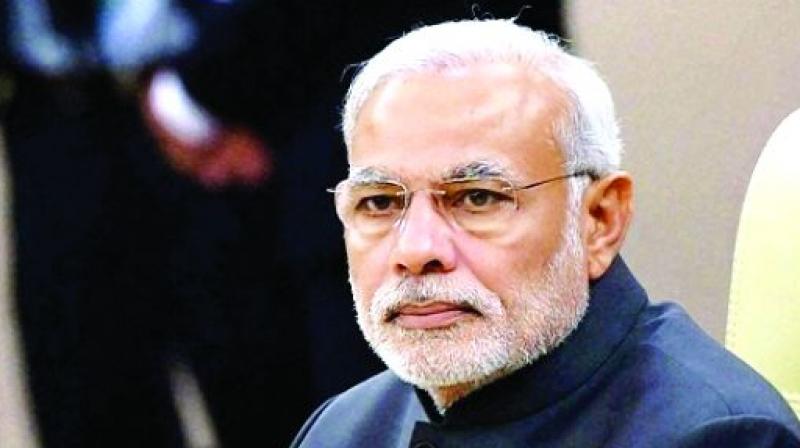Modi in Maldives: Time for relook at China BRI

Prime Minister Narendra Modi this week makes fleeting foreign voyages in between domestic electioneering, where he faces multiple and crucial elections to several state Assemblies in the Hindi belt, which had catapulted him into power in 2014. Domestic imperatives will in fact dominate even more strongly as the run-up to the Lok Sabha elections begins in 2019. In the past, Prime Ministers have scaled back their foreign commitments in similar circumstances, but for Mr Modi foreign policy has been a tool in his political image-making.
However, the external environment is today more challenging than during the first three years of his prime ministership, and there are fewer successes on offer.
He had two major overseas trips this week. The first was to the annual Asean summit in Singapore, on the sidelines of which were held both the India-Asean summit and the East Asia Summit (EAS), consisting of the 10 Asean nations and Japan, South Korea, China, plus India, Australia and New Zealand, besides Russia and the United States. The East Asia Summit is the premier gathering in Asia for strategic discussions on political, security and economic challenges. The Asia-Pacific Economic Partnership (Apec) summit, of which India is not a member, was held immediately after the EAS in Papua New Guinea. The G-20 meets in Argentina later this month. The challenges before the region are many, but the trade battles between the US and China, with tit-for-tat tariffs, is affecting business sentiments across the world. The absence of US President Donald Trump at the EAS and Apec summits, with Chinese President Xi Jinping attending the latter, has sent out a signal of modified, if not declining, American interest in the Asia-Pacific. The EAS was also dominated by China driving the discussion towards its favoured Regional Comprehensive Economic Partnership (RCEP), which was the Chinese response to the earlier proposed Trans Pacific-Partnership, that the US under President Trump has abandoned. India tried to introduce its conditions for its fruition, but would find tepid support from within the Asean bloc. With China dominating the space vacated by the US and Japan and Australia lowering their resistance, India turns to thoroughly survey its immediate periphery to secure its core interests at least there.
China’s assertiveness since the 2008 financial crisis has seen the Chinese presence incrementally expanded in South Asia, particularly in India’s maritime neighbourhood. The Chinese stranglehold on Sri Lankan infrastructure, particularly at the Hambantota and Colombo ports, discomforted India as the then President Mahinda Rajapaksa bent over backwards to satisfy Beijing. Mr Maithripala Sirisena’s election as President in 2015 did reverse the process, now stymied by the constitutional coup by Mr Sirisena and Mr Rajapaksa, ousting incumbent Prime Minister Ranil Wickremesinghe. This imbroglio still remains unresolved as the country’s highest court struck down the dissolution of Parliament and Mr Rajapaksa was unable to demonstrate his majority.
Mr Rajapaksa’s return may not, however, restore Sri Lanka’s China tilt, as it was his flirtation with China that caused the debt bubble resulting in the Sirisena government having to cede control over Hambantota port and its contiguous zone. But a similar drama is now playing out in the Maldives. In late September, Ibrahim Mohamed Solih, the joint Opposition candidate, was elected as President, defeating the incumbent Abdulla Yameen, who was hanging onto power by unconstitutional means since 2013. His presidency, like that of Mr Rajapaksa in Sri Lanka, saw the rapid intrusion of China in Maldivian infrastructure development, including the suspected leasing of some islands in perpetuity for potential military or reconnaissance use. The new President will be inaugurated on November 17. Meanwhile, two former Presidents are back in public view — with Mohammed Nasheed returning from exile and Maumoon Abdul Gayoom, Mr Yameen’s half-brother, released from internment. Prime Minister Narendra Modi has accepted the invitation to attend, though a subsequent stand-alone visit was being speculated on as Maldives was the only Saarc neighbour that he had refused to visit while Mr Yameen was in power. China will be represented by its culture minister.
Maldives occupies a crucial maritime position, just 400 km from India’s Malabar coast. Despite 1,200 islands, most of its population of about 325,000 is crammed on one main island. It has the negative distinction of the largest per capita contribution of fighters to global jihadi outfits like the Islamic State and Al Qaeda. Thus, for India, it has a two-fold significance — that it should not allow Chinese predatory infrastructure capture or be radical Islam’s nursery. Among those released from internment is Sheikh Imran Abdulla of the Religious Conservative Party, who will somewhat influence the new government. India will seek a stabile Maldives that only democracy can provide.
Before Prime Minister Modi’s arrival in the Maldives on Saturday, India has speed-delivered, after a refit at Visakhapatnam, a Coast Guard vessel. Maldivian exports have dropped this year and consist mainly of marine products. But the principal foreign exchange earner is tourism. How the new government rebalances between India and China will define Indo-Maldivian relations. In the past, some projects like the airport were seized from Indian firm GMR and perhaps passed into direct or indirect Chinese control. India would seek transparency over what, if any, islands have been leased to China. Maldivians have the Malaysian, Sri Lankan and now even Pakistani concerns before them about the Chinese Belt and Road Initiative (BRI) turning into debt traps.
However, India must realise that China’s presence in its maritime domain is unavoidable. Both nations must learn to coexist. India’s resistance to China’s BRI is getting isolated as even Japan and Australia are now grabbing the business opportunity in BRI projects across the Asia-Pacific. India should judge Chinese projects in its maritime neighbourhood by smarter red lines, which cannot mean a zero Chinese presence. Chinese tourists bring huge revenues to tourist destinations, including potentially to the Maldives, although the upper end is dominated by Europeans. Prime Minister Modi’s visit provides a good opportunity to begin this dialogue.

